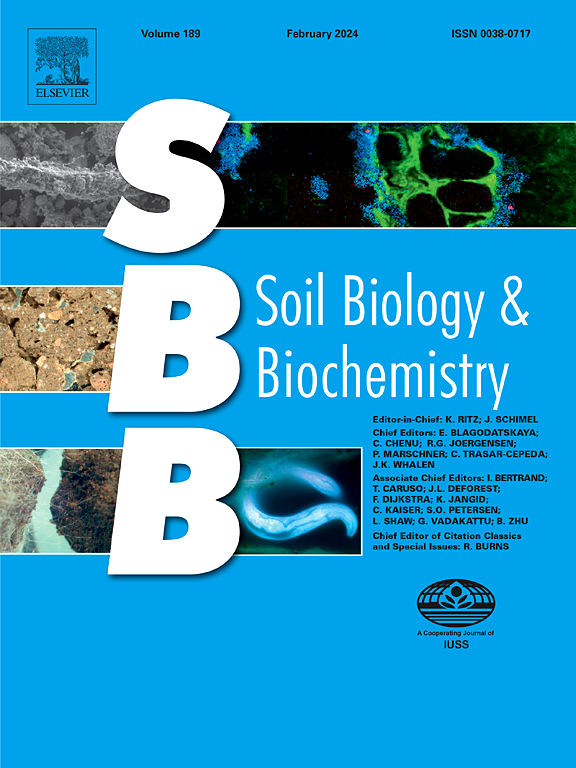根圈对亚高山森林土壤中的自由固氮作用贡献过大
IF 9.8
1区 农林科学
Q1 SOIL SCIENCE
引用次数: 0
摘要
根系活动在根圈中形成了一个独特的微生物热点,对自由生活固氮(FLNF)产生了深远的影响。然而,对根圈自由固氮作用及其对氮(N)预算的生态影响的实证评估仍然缺乏,尤其是对不同根系功能模块的评估。在这里,我们分别采集了附着在两种根功能模块(吸收根和运输根)上的根瘤土壤,并研究了氮限制亚高山针叶林中根瘤FLNF的速率(15N2吸收)和调节因子。根据根圈体积以及FLNF速率与温度之间的关系,将测得的速率进一步推断为年通量。我们发现,吸收根驱动的根圈 FLNF 速率(12.2 纳克 N g-1 d-1 与 7.5 纳克 N g-1 d-1)明显高于运输根,两个根圈分区的速率都远远超过了块状土壤中的速率(0.9 纳克 N g-1 d-1)。FLNF速率与土壤有机碳含量呈正相关,但与重氮营养群落的丰度或组成无明显关系。此外,当推断到生态系统水平时,吸收根根圈中的 FLNF 通量是运输根根圈中的 2 倍(0.13 vs. 0.04 kg N ha-1 yr-1)。总之,尽管这两个根圈只占土壤体积的 6.0%,但对土壤 FLNF 通量的贡献却高达 47.2%。总之,我们提供的经验证据表明,尽管根圈的体积有限,但它对亚高山森林土壤中的 FLNF 的贡献却不成比例。我们的研究结果还强调了根系功能分化在调节根圈 FLNF 中的关键作用,这对于将这一过程纳入生态系统级氮循环至关重要。本文章由计算机程序翻译,如有差异,请以英文原文为准。
The rhizosphere contributes disproportionately to free-living nitrogen fixation in subalpine forest soils
Root activity creates a unique microbial hotspot in the rhizosphere, profoundly regulating free-living nitrogen fixation (FLNF). However, empirical assessments of rhizosphere FLNF and its ecological consequences for nitrogen (N) budgets remain lacking, particularly for different root functional modules. Here, we separately collected rhizosphere soils attached to two root functional modules, absorptive roots and transport roots, and investigated the rates (15N2 incorporation) and regulators of rhizosphere FLNF in a N-limited subalpine coniferous forest. The measured rates were further extrapolated to annual fluxes based on the volume of the rhizosphere and the relationship between FLNF rate and temperature. We found that absorptive roots drove significantly higher rhizosphere FLNF rates than did transport roots (12.2 vs. 7.5 ng N g−1 d−1), with both rhizosphere compartments exhibiting rates well exceeding those in the bulk soil (0.9 ng N g−1 d−1). The FLNF rates were positively correlated with soil organic carbon content but showed no significant relationship with the abundance or composition of the diazotrophic community. Moreover, when extrapolated to the ecosystem level the FLNF fluxes were 2-fold greater in the rhizosphere of absorptive roots than in that of transport roots (0.13 vs. 0.04 kg N ha−1 yr−1). Taken together, despite representing only 6.0% of the soil volume, the two rhizosphere compartments contributed as much as 47.2% to the total soil FLNF fluxes. Overall, we provide empirical evidence that despite its limited volume, the rhizosphere contributes disproportionately to the FLNF in subalpine forest soils. Our findings also underscore the critical role of root functional differentiation in regulating rhizosphere FLNF, which is essential for integrating this process into the ecosystem-level N cycle.
求助全文
通过发布文献求助,成功后即可免费获取论文全文。
去求助
来源期刊

Soil Biology & Biochemistry
农林科学-土壤科学
CiteScore
16.90
自引率
9.30%
发文量
312
审稿时长
49 days
期刊介绍:
Soil Biology & Biochemistry publishes original research articles of international significance focusing on biological processes in soil and their applications to soil and environmental quality. Major topics include the ecology and biochemical processes of soil organisms, their effects on the environment, and interactions with plants. The journal also welcomes state-of-the-art reviews and discussions on contemporary research in soil biology and biochemistry.
 求助内容:
求助内容: 应助结果提醒方式:
应助结果提醒方式:


